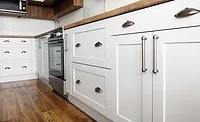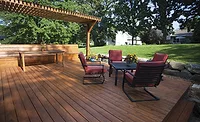Selecting Resins for Wood Coating Applications: A Guide for Formulators
Bayer MaterialScience LLC researchers have categorized the company’s 1K WB polyurethane technologies as well as the key performance properties for different applications, to provide formulators with an overview of the resins and their applicability to specific wood coating applications. This article presents an overview of the findings, which are designed to help streamline the resin selection process for wood coatings.
 Credit: Bayer MaterialScience LLC Credit: Bayer MaterialScience LLC
|
| Table 1 Click to enlarge |
Types of Polyurethane Dispersions (PUDs)
There are different types of backbones, or building blocks, for polyurethane dispersions: polyether, polyester and polycarbonate. Sometimes, two types of backbones are combined to formulate a PUD. It is possible to generalize about the advantages and disadvantages offered by each (Table 1).
There are self-crosslinking PUDs. These dispersions contain segments that will crosslink when initiated. Some types of self-crosslinking materials contain fatty acid segments, enabling them to oxidatively cure over time.
Critical Testing for the Wood Market
After becoming familiar with the combination of properties generally exhibited by the different types of PUDs, it is beneficial to understand the critical tests that should be conducted to determine which resins are best suited for the different end-use wood coating markets. Common tests are as follows:
• Dry time;
• Surface hardness (pendulum);
• Taber abrasion (CS-10, 1,000-cycles, 1,000-gram weight) to determine scratch and wear resistance;
• Chemical resistance (ethanol/water, acetone, Formula 409, water);
• Black Heel Mark Resistance (BHMR);
• Exterior durability.
Solvent-Free PUDs
After determining which tests are critical to the wood coatings market, researchers subjected a variety of solvent-free PUDs to these tests. Table 2 is a matrix researchers developed that plots how these PUDs performed to the tests outlined in the section above.
 Credit: Bayer MaterialScience LLC Credit: Bayer MaterialScience LLC |
| Table 2 Click to enlarge |
While these are all solvent-free PUDs, it is important to be mindful of co-solvents, which are often required to form a film at room temperature. Resin UH XP 4, however, is a unique material in that it does not require any co-solvents. As such, it can be formulated with very low (less than 50 g/L) VOCs, which is a particularly attractive attribute for some end-use markets. It is important to remember, however, that UH XP 4 is an oxidatively curing material, and therefore requires a dryer, or catalyst, to initiate the oxidative curing mechanism. This catalyst often contains a metal, such as cobalt, although newer, more environmentally friendly materials, such as iron, may also be used.
End-Use Application
Table 2 offers a good overview of how different PUDs perform in tests used by wood manufacturers. However, there is another important aspect that should be evaluated: the end-use application. Scuff resistance, for example – would likely be very important for flooring, but not for cabinetry. With this in mind, researchers also took a look at the requirements for several application areas: flooring, cabinetry, furniture, interior windows and doors, and exterior wood in an effort to aid formulators in selecting the optimal resin.
Wood Flooring
The researchers determined that BHMR, which evaluates if a scuff can be removed, is a critical test for wood flooring. For this application it is also important for coatings to be abrasion resistant (Taber abrasion). They should also be hard (pendulum hardness), because if the coating is soft, dirt will wear in, resulting in undesirable dirt paths. Based on these application-specific performance requirements, researchers again referred to the matrix in Table 2, concluding that UH 3 was the most optimal product for this market.
 Credit: Bayer MaterialScience LLC Credit: Bayer MaterialScience LLC |
| Table 3 Click to enlarge |
Kitchen Cabinets
One of the key properties for this market is chemical (stain) resistance. The primary test for this market is set forth by the Kitchen Cabinet Manufacturers Association (KCMA), in which coatings are exposed to such agents as mustard, coffee and vinegar. After a period of time, the agents are removed to determine if staining has occurred. Also important for cabinetry is superior abrasion resistance (Taber abrasion) and superior resistance to dirt (pendulum hardness).
Furniture
Superior resistance to dirt (pendulum hardness), abrasion (Taber abrasion) and water (water spot) were the most significant properties for furniture coatings. Additionally, superior chemical (stain) resistance to shoe polish, nail polish remover, soft drinks and other agents that might be commonly found in office environments was also identified as an important criterion for office furniture coatings.
Interior Doors and Windows
In addition to superior water and chemical resistance, good blocking time is also a key consideration for interior door and window coatings.
Exterior Wood
As may be expected, superior weathering properties – including good gloss retention, and no chipping, chalking, splitting or yellowing – are the most vital to the exterior wood market.
Optimal PUDs for Various Markets
Researchers took the properties most pertinent to the key application areas and integrated them with the solvent-free PUD property matrix (Table 2), creating a chart (Table 3) that indicates which resins might be a good fit for particular applications.
Researchers emphasize that this chart is intended to serve as a starting point for formulators, because the optimal material may not be a single material at all, but a blend.
Effect of Crosslinker Addition
While 1K WB dispersions offer a number of desirable properties, chemical resistance, adhesion or other properties can be further enhanced through the addition of crosslinkers. There are several chemistry options from which to choose – polyaziridine, polycarbodiimide and water-dispersible polyisocyanates.
Polyaziridine and polycarbodiimide offer easy dispersibility and low viscosity, but are pH sensitive and must have acid functionality for the polyaziridine/polycarbodiimide, respectively, to crosslink.
First-generation polyisocyanates are hydrophilically modified and therefore offer easy dispersibility. This option typically has lower isocyanate content and higher viscosity.
A second-generation polyisocyanate, another patented technology, is solvent free and ionically modified. One of the advantages of this technology is its high isocyanate content (23%) and very low viscosity, making it possible to formulate coatings with ultra-low VOCs.
It is important to keep in mind that to help ensure the optimal coating formulation, both the PUD being utilized and the end-use application should be considered when selecting a crosslinker.
Conclusion
There are a variety of 1K WB polyurethane resin options for wood coating applications. Finding the optimal technology requires a thorough understanding of not only resin properties, but also the applications in which the wood coatings will ultimately be used, such as flooring, cabinetry, furniture, interior windows and doors, and exterior wood.
While 1K WB resins offer a good balance of desirable properties, it is also important to keep in mind that the properties of WB coatings can be enhanced by the addition of a crosslinker into a formulation. Selecting the appropriate crosslinker may be dependent on the PUD being utilized.
Research and testing that have been conducted should help streamline the resin selection process. For formulators, this should translate into the ability to save valuable time, money and resources. Furthermore, it should facilitate the selection of the optimal resins that will achieve the desired performance for specific wood coating applications.
For more information, e-mail peg.kendi@bayer.com.
This paper was presented at the Southern Society for Coatings Technology Annual Meeting in 2010.
Looking for a reprint of this article?
From high-res PDFs to custom plaques, order your copy today!






